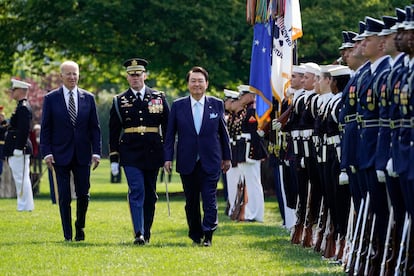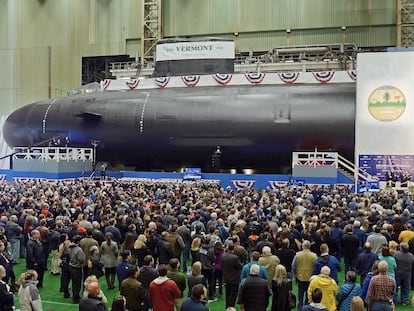United States and South Korea unveil new nuclear deterrence plan
‘A nuclear attack by North Korea against the United States or its allies and partners is unacceptable, and will result in the end of whatever regime were to take such an action,’ President Biden said

President Joe Biden and South Korea’s Yoon Suk Yeol announced Wednesday the two nations will bolster the response to North Korea’s persistent nuclear threat with an agreement that includes plans to dock U.S. nuclear-armed submarines in South Korea for the first time in over 40 years, bolster training between the two countries and improve information sharing between the allies.
The new extended nuclear deterrence effort was unveiled as Biden hosted Yoon for a state visit at a moment of heightened anxiety over an increased pace of ballistic missile tests by North Korea.
Biden delivered a blunt warning to Pyongyang at an afternoon Rose Garden news conference with Yoon, saying: “A nuclear attack by North Korea against the United States or its allies and partners is unacceptable, and will result in the end of whatever regime were to take such an action.”
Yoon said that the new commitment by the “righteous alliance” includes plans for bilateral presidential consultations in the event of a North Korean nuclear attack, the establishment of a nuclear consultative group and improved sharing of information on nuclear and strategic weapons operation plans.
“Sustainable peace on the Korean Peninsula does not happen automatically,” Yoon said.
Biden and Yoon aides have been working on details of the plan for months and agreed that “occasional” and “very clear demonstrations of the strength” of U.S. extended deterrence capabilities needed to be an essential aspect of the agreement, according to three senior Biden administration officials who briefed reporters ahead of the announcement.
The officials said the so-called Washington Declaration was designed to allay South Korean fears over the North’s aggressive nuclear weapons program and to keep the country from restarting its own nuclear program, which it gave up nearly 50 years ago when it signed the Nuclear Non-Proliferation Treaty. Yoon earlier this year said his country was weighing developing its own nuclear weapons or asking the U.S. to redeploy them on the Korean Peninsula.
The U.S. and South Korea also would coordinate more deeply on nuclear response strategy in the event of the North attacking the South — but operational control of such weapons would remain in U.S. control, and no nuclear weapons are being deployed onto South Korean shores.
“We are not going to be stationing nuclear weapons on the peninsula,” Biden underscored.
Biden said coordination between the U.S. and South Korea remains crucial in the face of increased North Korean threats and blatant violation of international sanctions. The president repeated that the U.S. remains open to talks with the North without preconditions.
“At the same time, we continue to seek serious a substantial diplomatic breakthrough for the DPRK to bolster stability on the peninsula,” Biden said of the North.
During a brief appearance before reporters at the start of their Oval Office talks, Biden stressed that both nations are committed to “doubling down on our cooperation as allies” as North Korea “ramps up its challenges.”
The state visit comes as the U.S. and South Korea mark the 70th year of the countries’ alliance that began at the end of the Korean War and committed the United States to help South Korea defend itself, particularly from North Korea. Approximately 28,500 U.S. troops are currently based in South Korea.
“Why did they sacrifice their lives for this faraway country and for the people that you’ve never met?” Yoon said of the U.S. troops who served during the war. “That was for one noble cause: to defend freedom.”
The agreement also calls for the U.S. and South Korean militaries to strengthen joint training and better integrate South Korean military assets into the joint strategic deterrence effort. As part of the declaration, South Korea will reaffirm its commitment to the Nuclear Non-Proliferation Treaty, an agreement signed by several major nuclear and non-nuclear powers that pledged their cooperation to stem the spread of nuclear technology, the officials said.
As a candidate for the presidency last year, Yoon said he would call for the increased deployment of U.S. bombers, aircraft carriers and nuclear submarines to South Korea as he looked to offer a firmer response to the North’s threats than his predecessor Moon Jae-in.
In the midst of the Cold War in the late 1970s, U.S. nuclear-armed ballistic missile submarines made frequent port visits to South Korea, sometimes two to three visits per month, according to the Federation of American Scientists. It was a period when the U.S. had hundreds of nuclear warheads located in South Korea.
But in 1991, the United States withdrew all of its nuclear weapons from the Korean Peninsula, and the following year Seoul and Pyongyang signed a joint declaration pledging that neither would “test, manufacture, produce, receive, possess, store, deploy or use nuclear weapons.” But as the North has repeatedly violated the joint declaration over the years, there’s been increased support in South Korea for the United States to return nuclear weapons to the country.
One Biden administration official cautioned it is “crystal clear” that there are no plans by the administration for “returning tactical or any other kind of nuclear weapon to the Korean Peninsula.” Instead, administration officials said they envision that the visit of ballistic missile submarines will be followed by the U.S. military more regularly deploying assets such as bombers or aircraft carriers to South Korea.
North Korea’s increasing nuclear threats, along with concerns about China’s military and economic assertiveness in the region, have pushed the Biden administration to expand its Asian alliance. To that end, Biden has thrown plenty of attention at Yoon as well as Japanese Prime Minister Fumio Kishida. Next week, Biden will host Philippine President Ferdinand Marcos Jr. for Oval Office talks.
In the past year, North Korea has been steadily expanding its nuclear arsenal, while China and Russia repeatedly block U.S.-led efforts to toughen sanctions on the North over its barrage of banned missile tests.
The stepped-up testing by North Korea includes the flight-testing of a solid-fuel intercontinental ballistic missile for the first time earlier this month. The recent test is seen as a possible breakthrough in the North’s efforts to acquire a more powerful, harder-to-detect weapon targeting the continental United States.
Besides nuclear deterrence, Biden and Yoon, and their aides, also are expected to discuss Russia’s ongoing war in Ukraine. The Biden administration has praised South Korea for sending some $230 million in humanitarian aid to Kyiv, but Biden would welcome Seoul taking an even bigger role in helping the Ukrainians repel Russia.
Yoon’s visit comes just weeks after the leaks of scores of highly classified documents that have complicated relations with allies, including South Korea. The papers viewed by The Associated Press indicate that South Korea’s National Security Council “grappled” with the U.S. in early March over an American request to provide artillery ammunition to Ukraine.
The documents, which cited a signals intelligence report, said then-NSC Director Kim Sung-han suggested the possibility of selling the 330,000 rounds of 155 mm munitions to Poland, since getting the ammunition to Ukraine quickly was the United States’ ultimate goal.
Asked at the joint news conference if the leak came up in their private talks, Yoon replied, “We are communicating between our two countries.”
Later Wednesday, Biden and first lady Jill Biden will honor Yoon and his wife, Kim Keon Hee, at a state dinner at the White House.
Sign up for our weekly newsletter to get more English-language news coverage from EL PAÍS USA Edition
Tu suscripción se está usando en otro dispositivo
¿Quieres añadir otro usuario a tu suscripción?
Si continúas leyendo en este dispositivo, no se podrá leer en el otro.
FlechaTu suscripción se está usando en otro dispositivo y solo puedes acceder a EL PAÍS desde un dispositivo a la vez.
Si quieres compartir tu cuenta, cambia tu suscripción a la modalidad Premium, así podrás añadir otro usuario. Cada uno accederá con su propia cuenta de email, lo que os permitirá personalizar vuestra experiencia en EL PAÍS.
¿Tienes una suscripción de empresa? Accede aquí para contratar más cuentas.
En el caso de no saber quién está usando tu cuenta, te recomendamos cambiar tu contraseña aquí.
Si decides continuar compartiendo tu cuenta, este mensaje se mostrará en tu dispositivo y en el de la otra persona que está usando tu cuenta de forma indefinida, afectando a tu experiencia de lectura. Puedes consultar aquí los términos y condiciones de la suscripción digital.
More information
Archived In
Últimas noticias
Imelda Castro, the woman who wants to rule the cartel battleground of Sinaloa
The new victims of the Republican war on Obamacare: Millions hit by soaring health insurance premiums
A country divided on migrant rights: Some US states expand protections while others restrict them
Venezuela authorizes the release of another 87 political prisoners
Most viewed
- David King, chemist: ‘There are scientists studying how to cool the planet; nobody should stop these experiments from happening’
- Reinhard Genzel, Nobel laureate in physics: ‘One-minute videos will never give you the truth’
- Oona Chaplin: ‘I told James Cameron that I was living in a treehouse and starting a permaculture project with a friend’
- Sinaloa Cartel war is taking its toll on Los Chapitos
- The Interoceanic Train, the Mexican alternative to the Panama Canal










































